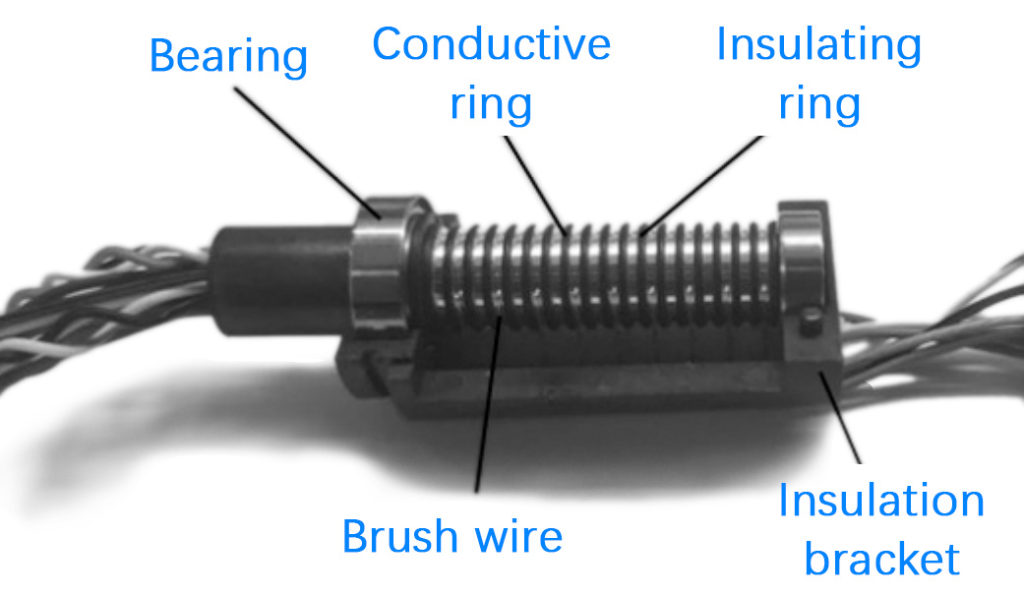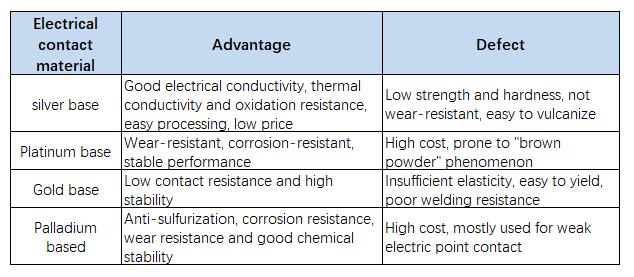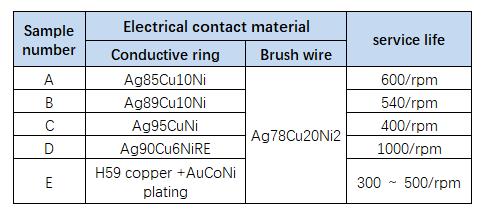Influence of Electrical Contact Material on Life and Reliability of Conductive Slip Ring
A conductive slip ring is a precision conduction device that transmits an image, video, digital, network, control and other signals from one stationary mechanism to another motion mechanism. It is widely use in intelligent security, industrial automation, clean energy, instrumentation, aerospace and other fields. With the development of defense technology and Internet technology, conductive slip ring, a precision conductive device, requires higher reliability of its power and data transmission.
For a long time, slip rings with high precision, long service life and good stability are mainly used in the military field, such as military radar, satellite, high-end weapons and other precision equipment, while the reliability and service life of civil industrial slip rings are relatively low. However, in today’s digital security era of intelligent interconnection, high-definition network video signal transmission has put forward higher requirements for conductive sliding ring devices.
1. Life Influence Factor of Contact Cap-type Conductive Slip Ring
In the field of defense and security, electrical contact cap type conductive slip ring are commonly used, which mainly transmit current, control signal, network signal, etc. Its internal structure is divided into two parts: the stator and the rotorwith the signal input / output conductor. The rotor follows the rotating mechanism to rotate at any angle, and the stator is fixed on the stationary mechanism to remain motionless, they remove the secondary signal through movement.
The rotor is composed of conductive rings, insulating materials, external wires and bearings and other parts; The conductive ring and rotor wire are welded and fixed on the central axis, and the conductive ring of different channels are separated by through insulating material. The stator is composed of electrical brush, bonding materials, insulation support, flange shell and other parts. The brush wire and the stator end wire are weld and fixed on the insulation bracket through the resin glue, and the outside is protected by wrapping with the flange shell. Among them, the conductive slip ring is to form a pair of contact pairs through the internal conductive ring and brush wire to realize the signal connection of rotor and stator in the process of relative motion.

There are some factors that influences the life and reliability of a contact cap-type conductive slip ring, like contact resistance, dynamic contact resistance fluctuation value, friction torque between contact pairs, matching degree of characteristic impedance, system common mode interference, etc. And these factors are closely related to the internal structure, electrical contact materials of the conductive slip ring, and the contact mode and pressure of the friction pairs. The study shows that, in order to transmit the network signals normally, the dynamic resistance change value between the single channels of the conductive slip ring needs to be controlled within 30 m Ω .
When the dynamic contact impedance fluctuation occurs, the network signal passes through the conductive slip ring, which causes the network signal loss and affects the reliability and life of the conductive slip ring. To reduce the dynamic resistance change value of the conductive slip ring, electrical contact materials with good electrical conductivity are required. The better the conductive wear resistance of the electrical contact materials, the greater the contact pressure, the smaller the contact resistance and dynamic contact resistance fluctuation value, the higher the signal transmission reliability, but the more serious the wear of the friction pair is.
2. Contact Materials of the Conductive Slip ring
In the transmission process of current and electrical signal, the conductive ring and the electrical brush wire stay in a long-term sliding contact state. Under the work of load and dual coupling of current, mechanical wear and electrical wear occur, which directly impact the life cycle and reliability of the electrical slip ring. Therefore, to meet the requirements of its life cycle and contact stability, the electrical materials like conductive ring and electrical brush, usually use the precious metal materials. The commonly used electrical contact materials mainly include silver based electrical contact materials, platinum based electrical contact materials, gold based electrical contact materials and palladium based electrical contact materials. The table below summarized the advantages and disadvantages of the materials.

In practical application, the electrical contact material of a single element often fails to meet the use requirements of the conductive slip ring devices. So far, the commonly used conductive ring and brush wire materials are mainly alloys. As a pair of electrical contact friction pairs, the wear resistance and electrical contact performance should be considered comprehensively.
According to the different applications, the brush wire materials mainly include silver based alloy materials AgCuNi, and gold based alloy materials AuNi, AuNiGd. The experiment shows that the brush wire made of Au base alloy material has good wear resistance, and the addition of rare earth metal elements can make up for the defect of the poor brush melt welding. So that the electrical brush wire would obtain a good electrical and mechanical comprehensive performance. Au base alloy material is mainly used for electrical brush wire with high performance conductive slip ring. And the electrical brush wire made of Ag base alloy material has obvious advantages such as easy processing and low price, which is widely used in ordinary industrial products.
The selection of conductive ring electrical contact materials is more considered the conductivity coefficient, wear resistance coefficient and antioxidant capacity, AgCu, AgCuV, AuAgCu, PtIr, PdNiCu and other materials are commonly used. Such precious metal alloy materials usually have higher prices. However, the amount of the conductive ring used in the conductive slip ring devices is relatively large, so in the field of ordinary industrial conductive slip ring, precious metal are usually plated on the matrix of A g C u alloy to obtain a balance between cost and conductive, welding, wear resistance and other properties.
In the field of defense and security, the electrical brush wire and the conductive ring are handled with AgCuNi alloy and H59 copper alloy materialsrespectively. In this way, electrical contact materials can be conducted and easy to process, but also improve the wear resistance of mutual friction pair. Figure 2 is a schematic diagram of the conductive ring and the brush wire.

3. Reliability of Conductive Slip Rings for Different electrical Contact Materials
3.1 Experiment Design
To investigate the relationship between electrical contact materials and conductive slip ring lifetime and reliability, the existing structure of the general conductive slip ring in the security industry is adopted shown as figure 1. under the condition of keeping contact forms and pressure unchanged, make the conductive slip ring by replacing different electrical contact materials. Testing the service life of conductive slip ring made by different electrical contact materials, and comparing the friction status of the materials. So that to study the relationship between signal transmission stability between electrical contact materials and conductive slip ring networks.
The electrical brush wires in the electrical contact materials use the common Ag78Cu20Ni2 material. Five kinds of conductive slip rings are tested by replacing different conductive ring electrical contact materials. The specific test transmission link is shown in Figure 3.

The camera and the conductive slip ring test sample are connected through the network cable, and then connected to the network hard disk video recorder (NVR, Network Video Recorder), and the video signal transmission screen is displayed in real time. The test principle is to simulate the actual application of conductive slip ring devices in security products. The conductive slip ring is linked as a network signal transmission link, and it is rotated at a constant rate on the test tooling under high and low temperature cycle conditions, as shown in the schematic diagram of Figure 4. The network transmission stream of all conductive slip rings is set to 4096 Kb/S, and the network signal transmission of conductive slip rings is judged by switching on and breaking the video signal.

3.2 Experiment Result
After several times of experiments, excluding the interference from other factors in the signal transmission link of the conductive slip ring network. The cumulative rotation speed recorded by the test tooling is taken as the service life of the conductive slip ring when the video signal is broken.
Comparing the test results, the service life of conductive slip rings made from different electrical contact materials is different. The conductive ring and brush wire of the electrical contact friction pair of samples A, B and C are of AgCuNi material. The difference lies in the different Ag content. The data shows that at the Ag content of 78%, the higher the Ag content of the conductive ring material, the lower the service life of the corresponding conductive slip ring device. Under the condition that the brush wire material is AgCuNi constant, when added precious metal element into the conductive ring AgCuNi alloy, the service life of the conductive slip ring is significantly improved, reaching 10 million RPM, corresponding to the test data of sample D. In addition, after plating 1 ~ 3μm of AuCoNi alloy coating on the surface of the traditional H59 copper material, the service life of the conductive slip ring increases with the increase of the gold plating layer thickness, between 3 million to 5 million RPM.

3.3 Result Analysis
3.3.1 Dynamic Contact Resistance Analysis of Electrical Contact Materials
Analyzing the dynamic resistance change value of five kinds of mutual matching friction pairs conductive slip rings made of different electrical contact materials. The statistical analysis of the dynamic resistance change data is shown in Figure 4. According to the statistical data analysis, with the increase of Ag content in the electrical contact material, the change value of the dynamic contact resistance of the conductive slip ring gradually decreases, which is related to the good conductivity of Ag. The increasing ratio of Ag content in the conductive ring increases the electron mobility in the alloy materials, reduces the contact resistance between the friction pairs effectively, and decreases the fluctuation values of the dynamic impedance.
Comparing the dynamic contact resistance of samples A, B, C and D, it is found that the fluctuation values of AgCuNi alloy pairs are lower than H59 friction pairs composed of copper plating AuCoNi alloy.
3.3.2 Hardness Analysis of Electrical Contact Materials
To investigate the relationship between the hardness and wear conditions of different kinds of electrical contact materials. The surface hardness of the electrical contact alloy material was tested using a Micro Vicker HV-1000Z microtester with the following test principle:

F refers to the loading force; S refers to the area of the lozengeindentation; α refers to the angle between the opposite faces of the diamond indenter, 136°; D refers to the arithmetic average of the indentation.
The test result is shown in Figure5, the microscopic Vickers hardness of the brush wire material is HV187.1, while with the increase of Ag content in the silver alloy material of didferent conductive ring, the microscopic Vickers hardness hardness decreases gradually. When the rare earth metal element is added to the AgCuNi alloy, the minimum hardness value of HV 101 is obtained, which is much lower than the surface hardness of H59 copper alloy. Combined with the service life analysis of the conductive slip ring devices of different electrical contact materials, the conductive ring of HV 101 and the brush wire of HV 187.1 are beneficial to improve the stability of the signal transmission of the conductive slip ring network, which makes the highest service life of conductive slip rings.


3.3.3 Micro Structural Analysis of the Electrical Contact Materials
The surface morphology and micro organization of the electrical contact materials were further analyzed under microscopic conditions using Leica-CMS optical microscope and JSM-7610F Plus scanning electron microscopy, with micro graphs shown in Figure 6.
Comparing the conductive ring and the brush wire after the life test of different electrical contact materials, it is found that sample with 95% silver content has a serious mechanical wear of the conductive ring, and more mental abrasive dust, corresponding to a and b in Figure 6. Adding rare earth element to AgCuNi alloy, after the 10 million rpm life test, the conductive ring and the brush wire are less worn, corresponding to c and d in Figure 6. Therefore, combined with the microscopic Vikers hardness test data, the higher the Ag content is in the, the less of the hardness of the conductive ring is. In this way, he sticky wear and grinding wear are easy to occur in the motion friction pair of electrical contact. With the increase of friction movement, more metal wear particles comes our, which can directly affect the dynamic contact resistance of conductive slip ring, and cause unstable the signal transmission, thus the service life is affected.

In addition, the conductive ring material of sample E is H59 copper gilt of HV182.4 Vikers hardness. Combined it with the brush wire of AgCuNi, HV187.1 Vikers hardness as a friction pair. after life test, the brush wire was worn and broken at the most serious level, shown as figure e and f. This shows that when the hardness of the conductive ring and the brush wire is close, the main factor affecting the signal transmission stability of the conductive slip ring network is mechanical wear. The relative movement of the conductive ring and the brush wire makes the relatively weak brush wire wear seriously, or even the brush wire wear off, which is not favorable to the improvement of the life of the conductive slip ring.
Analyzing the micromorphology of the AgCuNiRE and AgCuNi alloys by using JSM-7610Fp Plus scanning electron microscope, and the test result is shown in Figure 7.As seen from the SEM image, the AgCuNiRE electrical contact material showed less wear than the AgCuNi alloy material, which means under the same conditions, the addition of rare earth metal RE to AgCuNi electrical contact materials can effectively improve its wear resistance and ensure the stability of the signal transmission.
4. Summary
This paper studied the characteristics of different electrical contact materials and concluded the following conclusions:
1) During the movement of the conductive slip ring, the friction pair is subject to the dual coupling effect of mechanical wear and electrical wear. The traditional conductive slip ring electrical contact material H59 copper gold-plated conductive ring and Ag78Cu20Ni2 brush wire constitute a friction pair, both the hardness is between HV180 and HV190. They mainly have mechanical wear like adhesive wear and grinding wear, seriously will lead to brush wire wear off, and ultimately affect the stability of network signal transmission.
2) In the conductive slip ring device, the brush wire with a hardness of HV101 and the conductive ring of HV187.1 is a reasonable hardness fit, which is favorable to reduce the mechanical wear between materials, and improve the conductivity of the slip ring.
3) Increasing the proportion of Ag in the electrical contact materials can effectively reduce the conductance, the dynamic contact impedance of the electrical slip ring. And it will also reduce the hardness of electrical contact material, which is beneficial to improve the signal transmission stability.
4) Adding RE to Ag90Cu6Ni alloy can prevent the occur and extend of internal lattice defects of the material, ensure the network transmission stability and reliability of the conductive slip ring, and increase its service life by 85% to reach 10 million RPM.